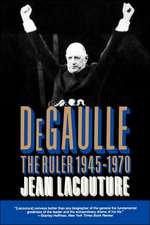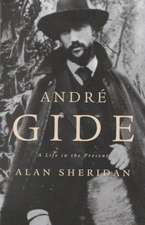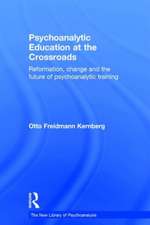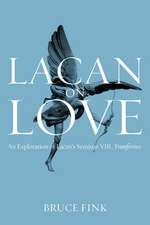The Violence of Interpretation: From Pictogram to Statement: The New Library of Psychoanalysis
Autor Piera Aulagnier Traducere de Alan Sheridanen Limba Engleză Paperback – 8 mar 2001
Piera Aulagnier's The Violence of Interpretation bridges the work of Winnicott and Lacan, putting forward a theory of psychosis based on children's early experiences. The author's analysis of the relationship between the other's communications and the infant's psychic experience. and of the pre-verbal stage of development of unconscious fantasy starting from the 'pictogram', have fundamental implications for the psychoanalytic theory of development. She developed Lacan's ideas to enable the treatment of severe psychotic states.
Containing detailed discussion of clinical material, and written in the author's precise yet provocative style, The Violence of Interpretation is a welcome addition to the New Library of Psychoanalysis.
Din seria The New Library of Psychoanalysis
- 5%
 Preț: 293.44 lei
Preț: 293.44 lei - 5%
 Preț: 331.64 lei
Preț: 331.64 lei - 5%
 Preț: 286.68 lei
Preț: 286.68 lei - 5%
 Preț: 295.02 lei
Preț: 295.02 lei - 5%
 Preț: 298.13 lei
Preț: 298.13 lei - 5%
 Preț: 250.75 lei
Preț: 250.75 lei - 5%
 Preț: 294.02 lei
Preț: 294.02 lei - 5%
 Preț: 233.65 lei
Preț: 233.65 lei - 5%
 Preț: 273.04 lei
Preț: 273.04 lei - 5%
 Preț: 344.75 lei
Preț: 344.75 lei -
 Preț: 295.40 lei
Preț: 295.40 lei - 5%
 Preț: 295.21 lei
Preț: 295.21 lei - 5%
 Preț: 762.85 lei
Preț: 762.85 lei - 5%
 Preț: 373.84 lei
Preț: 373.84 lei - 5%
 Preț: 333.69 lei
Preț: 333.69 lei - 5%
 Preț: 233.59 lei
Preț: 233.59 lei - 5%
 Preț: 231.82 lei
Preț: 231.82 lei - 5%
 Preț: 264.13 lei
Preț: 264.13 lei - 5%
 Preț: 266.39 lei
Preț: 266.39 lei - 5%
 Preț: 295.41 lei
Preț: 295.41 lei - 5%
 Preț: 296.08 lei
Preț: 296.08 lei -
 Preț: 294.23 lei
Preț: 294.23 lei - 5%
 Preț: 316.84 lei
Preț: 316.84 lei - 5%
 Preț: 289.19 lei
Preț: 289.19 lei - 5%
 Preț: 282.40 lei
Preț: 282.40 lei - 5%
 Preț: 287.54 lei
Preț: 287.54 lei - 5%
 Preț: 280.59 lei
Preț: 280.59 lei -
 Preț: 347.67 lei
Preț: 347.67 lei -
 Preț: 336.84 lei
Preț: 336.84 lei - 5%
 Preț: 349.43 lei
Preț: 349.43 lei - 5%
 Preț: 259.78 lei
Preț: 259.78 lei - 5%
 Preț: 260.93 lei
Preț: 260.93 lei - 5%
 Preț: 219.54 lei
Preț: 219.54 lei - 5%
 Preț: 218.59 lei
Preț: 218.59 lei - 5%
 Preț: 234.36 lei
Preț: 234.36 lei - 5%
 Preț: 235.04 lei
Preț: 235.04 lei - 5%
 Preț: 233.05 lei
Preț: 233.05 lei - 5%
 Preț: 253.71 lei
Preț: 253.71 lei - 5%
 Preț: 234.72 lei
Preț: 234.72 lei -
 Preț: 309.79 lei
Preț: 309.79 lei - 5%
 Preț: 294.71 lei
Preț: 294.71 lei - 5%
 Preț: 259.71 lei
Preț: 259.71 lei - 5%
 Preț: 287.94 lei
Preț: 287.94 lei - 21%
 Preț: 811.99 lei
Preț: 811.99 lei - 19%
 Preț: 246.34 lei
Preț: 246.34 lei - 5%
 Preț: 362.47 lei
Preț: 362.47 lei - 5%
 Preț: 367.79 lei
Preț: 367.79 lei - 11%
 Preț: 278.48 lei
Preț: 278.48 lei - 5%
 Preț: 365.37 lei
Preț: 365.37 lei
Preț: 282.09 lei
Preț vechi: 296.94 lei
-5% Nou
Puncte Express: 423
Preț estimativ în valută:
53.98€ • 56.51$ • 44.66£
53.98€ • 56.51$ • 44.66£
Carte tipărită la comandă
Livrare economică 05-19 aprilie
Preluare comenzi: 021 569.72.76
Specificații
ISBN-13: 9780415236768
ISBN-10: 0415236762
Pagini: 278
Dimensiuni: 156 x 234 x 20 mm
Greutate: 0.51 kg
Ediția:1
Editura: Taylor & Francis
Colecția Routledge
Seria The New Library of Psychoanalysis
Locul publicării:Oxford, United Kingdom
ISBN-10: 0415236762
Pagini: 278
Dimensiuni: 156 x 234 x 20 mm
Greutate: 0.51 kg
Ediția:1
Editura: Taylor & Francis
Colecția Routledge
Seria The New Library of Psychoanalysis
Locul publicării:Oxford, United Kingdom
Public țintă
Professional and Professional Practice & DevelopmentCuprins
Foreword by Harold Blum. Translators Note. Preface. Part I: From Pictogram to Statement. The Activity of Representation, it's Objects and It's Aim. General General Considerations. The State of Encounter and the Concept of Violence. The Primal Process and the Pictogram. The Postulate of Self-procreation. The Conditions Necessary for the Represntability of the Encounter. The Borrowing Made From the Senory Model by the Activity of the Primal. Pictogram and Specularisation. Pictogram and Erogenous Pleasure. The Re-production of the Same. Concerning the Activity of Thinking. The Concept of the Primal: Conclusions. The Fantasy Representaion of the Primary Process: Thing-presentation and Word-presentation. Thing-presentation and Body Fantasisation. Fantasy Representation and the Unconscious. The Postulate of the Primary and the Economic Principle that Results From it. The Prototypes of the Secondary. The Appearance of Word-presentation and the Changes that it Imposes on the Activity of the Primary. The System of Primary Meanings. The Pleasure of Hearing. From Desire to Hear to the Desire to Understand. Concerning the Perscuting Object. Signs and the Language of the Primary. Science and the Discourse of Others. The Space Where the I Can Come About. The Organisation of the Space Where the I Must Come About. The 'Word-bearer'. The Violence of Anticipation (the spoken shadow). The Effect of Repression and its Transmission. Conjunction and Syntax of A Desire. The Violence of Interpretation: the Risk of Excess. The Reduplication of Violence: the Basic Language. The Deferred Action of the Naming of the Affect. The Desire of the Father (for a Child, for that Child). The Encounter with the Father. The Narcissistic Contract. The I and the Conjugation of the Future: Concerning the Identificatory Project and the Splitting of the I Annex: What I Mean by the Concepts of Symbolic and Imaginary. Part II: The Interpretation of Violence and Primary Delusional Thinking. Concerning Schizophrenia: the Potential for Psychosis and Primary Delusional Thinking. Schizophrenia, Paranoia, Primary Delusional Thinking: General Considerations. The Space in Which Schizophrenia Can Come About. The Failure of Repression in the Mother's Discourse. Excessive Violence : The Appropriation by the Mother of the Child's Activity of Thinking. Forbidden Knowledge and Delusional Theories Concerning Origins. The Story of Mme B and Primary Delusional Theory Concerning Origins. The Necessary Factor for Psychotic Potentiality to Remain Such. The Historical Reality and the Effect of Reduplication. Concerning Paranoia: Primal Scene and Primary Delusional Thinking. The Fantasy of the Primal Scene and Infantile Sexual Theories. The Conditions Necessary for Fantasy Reelaboration. The 'heard' Scene and its representation in Paranoia. Accounts Heard. The 'Family Portrait': Failed Idealisation and the Appeal to the Persecutor. What the Child 'hears' and the 'Delusional Theory Concerning Origins'. The Theses Defended in the Trial to the Persecutor. M.R's Story. By Way of Conclusion: the Three Ordeals that Delusional Thinking Re-shapes.
Notă biografică
Piera Aulagnier was a French Psychoanalyst in private practice, and a prominent member of the International Psychoanalytic Association. She died in 1991.
Recenzii
"...the single most important contribution to the psychoanalytic understanding of psychosis published during the last twenty years..." - Otto F. Kernberg, President International Psychoanalytical Association
"Aulagnier's book is considered a masterpiece in the French Psychoanalytic Community." - Dr Francis Baudry
"This book is remarkable for its depth and originality" - André Lussier
'...the single most important contribution to the psychoanalytic understanding of psychosis published during the last twenty years...' - Otto F. Kernberg, President International Psychoanalytical Association
'Aulagnier's book is considered a masterpiece in the French Psychoanalytic Community.' - Dr Francis Baudry
'This book is remarkable for its depth and originality' - André Lussier
'La violence de I'interpretation by Piera Aulagnier has finally been translated into English, twenty-six years after its first publication. This work will be of interest to English-speaking readers for a variety of reasons. First, it bears witness to an essential stage in the career of a deeply individual author, who has enriched contemporary French psychoanalysis by, in particular, shedding new light on the study of psychosis. Secondly, the English-speaking reader, aware of the debates between Melanie Klein and Winnicott, will read with interest the author's elaborations on the origins of psychical life, the weight of reality in the constitution of the psyche of the subject, and the links between this reality and the maternal body and psyche. Thirdly, the central place the author gives to identification and to the 'identificatory project' will catch the reader's eye.' - Helène Troisier, Review in IJPA 83 (1), 2002.
'Aulagnier sees psychic development as balanced between drives, the need for satisfaction, and thought, the need "to make sense". In working with psychotic patients, she found that communications from the mother (or the parents), both in words and in action, had led either to painful answers to essential questions concerning how the child came to have life or to secrets that could not be spoken or thought. The problematic questions in psychosis are questions of origin: Did you desire me? How did I come to be? She describes a pattern in which the mothers of future psychotic patients did not want a child, or did not want this child. The mother imposes on the child, to an excess degree, her own idea of how the child is to behave and think. The child is not just to eat, but to eat "properly"; the child is not to sleep, but to sleep "properly". The child experiences this psychic intrusion as violence ... When analyst and patient, each firmly committed to a tradition of meaning, engage each other, they experience the violence of another’s mind imposing a distorted and alien mode of understanding. This is similar to what the patient experienced in childhood; the analyst experiences the ambiguous "psychotic feel".' - K. McKenzie - Journal of the American Psychoanalytic Association Vol 51 No2, 2003
"Aulagnier's book is considered a masterpiece in the French Psychoanalytic Community." - Dr Francis Baudry
"This book is remarkable for its depth and originality" - André Lussier
'...the single most important contribution to the psychoanalytic understanding of psychosis published during the last twenty years...' - Otto F. Kernberg, President International Psychoanalytical Association
'Aulagnier's book is considered a masterpiece in the French Psychoanalytic Community.' - Dr Francis Baudry
'This book is remarkable for its depth and originality' - André Lussier
'La violence de I'interpretation by Piera Aulagnier has finally been translated into English, twenty-six years after its first publication. This work will be of interest to English-speaking readers for a variety of reasons. First, it bears witness to an essential stage in the career of a deeply individual author, who has enriched contemporary French psychoanalysis by, in particular, shedding new light on the study of psychosis. Secondly, the English-speaking reader, aware of the debates between Melanie Klein and Winnicott, will read with interest the author's elaborations on the origins of psychical life, the weight of reality in the constitution of the psyche of the subject, and the links between this reality and the maternal body and psyche. Thirdly, the central place the author gives to identification and to the 'identificatory project' will catch the reader's eye.' - Helène Troisier, Review in IJPA 83 (1), 2002.
'Aulagnier sees psychic development as balanced between drives, the need for satisfaction, and thought, the need "to make sense". In working with psychotic patients, she found that communications from the mother (or the parents), both in words and in action, had led either to painful answers to essential questions concerning how the child came to have life or to secrets that could not be spoken or thought. The problematic questions in psychosis are questions of origin: Did you desire me? How did I come to be? She describes a pattern in which the mothers of future psychotic patients did not want a child, or did not want this child. The mother imposes on the child, to an excess degree, her own idea of how the child is to behave and think. The child is not just to eat, but to eat "properly"; the child is not to sleep, but to sleep "properly". The child experiences this psychic intrusion as violence ... When analyst and patient, each firmly committed to a tradition of meaning, engage each other, they experience the violence of another’s mind imposing a distorted and alien mode of understanding. This is similar to what the patient experienced in childhood; the analyst experiences the ambiguous "psychotic feel".' - K. McKenzie - Journal of the American Psychoanalytic Association Vol 51 No2, 2003
Descriere
Bridges the work of Winnicott and Lacan, putting forward a theory of psychosis based on children's early experiences.




























